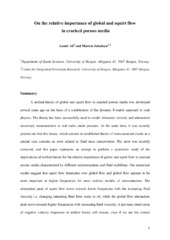On the relative importance of global and squirt flow in cracked porous media
Journal article
Submitted version
Permanent lenke
https://hdl.handle.net/1956/5031Utgivelsesdato
2014Metadata
Vis full innførselSamlinger
- Department of Earth Science [1050]
Originalversjon
10.1007/s40328-014-0049-5Sammendrag
A unified theory of global and squirt flow in cracked porous media was developed several years ago on the basis of a combination of the dynamic T-matrix approach to rock physics. The theory has been successfully used to model ultrasonic velocity and attenuation anisotropy measurements in real rocks under pressure. At the same time, it was recently pointed out that this theory, which contain an established theory of interconnected cracks as a special case contains an error related to fluid mass conservation. The error was recently corrected, and this paper represents an attempt to perform a systematic study of the implications of unified theory for the relative importance of global and squirt flow in cracked porous media characterized by different microstructures and fluid mobilities. Our numerical results suggest that squirt flow dominates over global flow and global flow appears to be more important at higher frequencies for more realistic models of microstructure. The attenuation peak of squirt flow move towards lower frequencies with the increasing fluid viscosity i.e. changing saturating fluid from water to oil, while the global flow attenuation peak move towards higher frequencies with increasing fluid viscosity. A previous observation of negative velocity dispersion in unified theory still remain, even if we use the correct effective wave number, when dealing with the phenomenon of wave-induced fluid flow in models of cracked porous media where global flow effects dominates. The attenuation peak of the global flow obtained using the correct wave number is always shifted to the left as compared to the approximate solution. At seismic frequencies global flow effects are not so important and needs very high permeability and low viscosity to have an effect.
